Army Art Posters and Prints
World War II: The Early Years
CMH Pub 70-46;
Not Available through GPO sales.
10 full-color 11" X 15 1/2" reproductions of paintings by Army Artists of World War II. Each of the prints includes the name of the work, the general location it depicts, and the name of the artist. The extended caption on each print provides background information on the subject matter illustrated. The artists whose work is represented here actually witnessed the scenes they portrayed, and in some cases the words in the caption are those of the creator of the artwork. In others the caption simply helps put the scene in context. This print set was designed and produced by the U.S. Army Center of Military History to commemorate the fiftieth anniversary of World War II. The pictures and words are in remembrance of the sacrifices and accomplishments of all the men and women who served in World War II. Individual prints may not be requested.
* View this publication online.
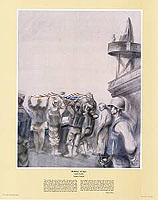
BURIAL AT SEA - South Pacific
by Sidney Simon
"This youth, the first of their outfit, had gone quickly, silently, without having seen the terrors, the muck, the grime, the great adventure. The unknown future supplanted by the sudden frightening appearance of reality was seen in all their curious faces, as they watched. The boy's fellow members in the Company Mess struggled with the flag draped stretcher up the hatch way, onto the deck, and finally placed it to rest on the saw horse & rail. Suddenly the maddening roar of silence as the ship's motors stopped, and the ever existent pulse & throb of the heart of the ship turned to silently roll in the evening, quiet except for the voice of the chaplain as he read from the small yellow card attached to the Bible. There was no breeze, no clouds. There was nothing. The chaplain's prayer died out, the flag was lifted, the board tilted, and the body slipped into the sea. The salute was fired and the pulse & throb, louder than ever, beat through the ship."
- Sidney Simon
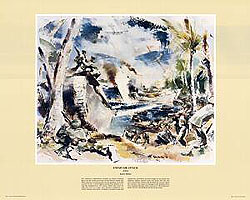
ENEMY AIR ATTACK - Arawe
by Barse Miller
The American amphibious assaults on House Fireman Beach on the Arawe peninsula of New Britain Island met little resistance on the ground, but the Japanese were able to send twenty or thirty fighter aircraft from Rabaul to attack the landing force. The beach, which had room for only two LCTs at a time, soon became congested as a newly formed shore party, working to unload troops and equipment, provided a lucrative target for air attack. The Japanese fighters arrived some two hours after the first wave had landed, strafed and bombed the area for about five minutes, but caused no damage to the landing forces. They departed abruptly when American P-38s flying overhead cover for the landing arrived on the scene.
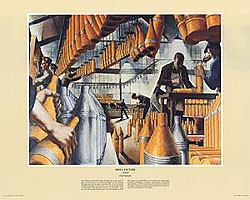
SHELL FACTORY - Detriot
by Paul Sample
Well before the United States became an active participant in World War II the industrial might of the country was gearing itself for greater production of war materiel. President Franklin D. Roosevelt, in one of his fireside chats in December 1940, declared that the United States "must become the arsenal of democracy." By the middle of 1942, the output of ammunition far exceeded any earlier rate; monthly production of artillery ammunition had tripled since the end of 1941. Production lines delivered well over 32 million rounds of artillery ammunition to the Army in the first six months of 1942 alone.
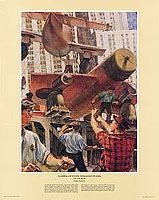
LOADING OF THE VULTEE VENGEANCE PLANES - New York Harbor
by Julien Binford
In 1940 the British Purchasing Commission ordered 700 Vultee Vengeance aircraft for the Royal Air Force (RAF). The Vengeance, christened by Lady Halifax, wife of the British ambassador to the United States, flew in July 1941; the first production model was completed almost a year later in June 1942. Designed specifically for dive-bombing, the Vengeance saw service with the RAF in India and Burma before being transferred to noncombat duties. The Army Air Forces acquired relatively few of the planes and soon relegated them to target-towing duty, although some did become test-beds for development of the B-29 engine.
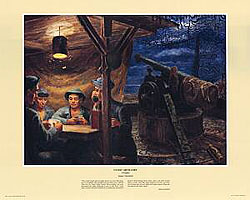
COAST ARTILLERY - Trinidad
by James Turnbull
"This small island with its single house was once the property of a resident [of] Trinidad and was taken over and left intact by the Army. Eight Puerto Rican soldiers are now stationed here after replacing a crew of the 99th. Their only contact with their battery is by telephone and motor launch which brings them food, water and mail several times a week. They like their isolation for they are their own bosses and are provided with larger rations than are the men at the main camp."
- James Turnbull
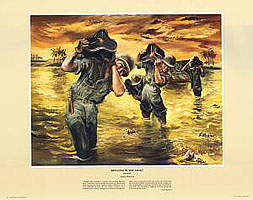
BRINGING IN THE AMMO - Rendova
by Aaron Bohrod
"Supplies kept pouring in: rations, ammunition, barracks bags. These were stacked on the first patch of solid ground found beyond the beach. Symbolic flags of different colors were unfurled to mark off the various dumps. There seemed to be a certain amount of confusion though, too, there was a relaxation on the part of the men when they saw that the landing had been almost wholly unopposed. The predominant crouching, crawling, gun handling aspect of the war changed to a tugging, carrying, piling, digging and wiring aspect."
- Aaron Bohrod
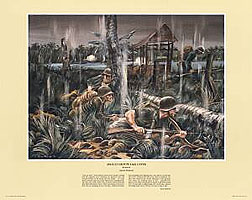
ASSAULT GROUPS TAKING COVER - Rendova
by Aaron Bohrod
"Here we were," Aaron Bohrod wrote in his journal. Fearing that the Japanese were "awaiting our approach past the wooded section of the beach into the jungle... we crept slowly forward, past and under barbed wire entanglement. The men rose, made a dash of ten or twenty feet forward and then threw themselves down. There were plenty of sound effects. Fire was popping all over the place. Additional barges kept unloading their fighting men, who, like us, moved into the wood." American fire died away when no Japanese soldiers were found in the woods. Although it was apparent that �there was nothing much to fear... apprehensive glances were often cast upward for snipers in the tall coconut trees. Occasionally a trigger-happy boy would take a shot at the foliage heart of one of these trees just to play it safe."
- Aaron Bohrod
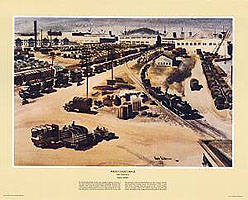
WEST COAST DOCK - San Francisco
by Barse Miller
In World War II the Army ran a global logistics system, a key part of which was transoceanic shipping. Between December 1941 and December 1945 the Army moved over 132 million measurement tons of cargo overseas by ship. San Francisco, one of ten key ports used by the Army, was the primary port of embarkation for the Central, South, and Southwest Pacific Areas. In December 1941 it handled more tonnage than any port in the United States, and its wartime total of 25 million tons was second only to the 38 million tons shipped from the port of New York.
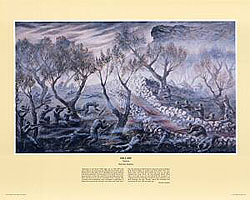
HILL 609 - Tunisia
by Fletcher Martin
"Skirmish of the Stone Walls high up on Hill 609 took place early in the morning, just after the cloud blew away. Americans on the right can be identified by round helmets and green uniforms. At one point in the battle three Germans tried to confuse the Americans by getting around behind, but they were shot by Hawaiian Lieut. Cockett. The Germans had insufficient cover and began to pull back. A Stuka flew around the cliff and went back and forth strafing. The Americans lifted up their machine guns and fired at it until it began to smoke and went away. Two Germans came out with their hands up. One of our men jumped out to get them. He was instantly killed. Then other men had to go out and kill both the Germans. A sergeant stuck his head up to look for more Germans, was shot between the eyes. Finally, when the Germans had lost about 40 men, the rest gave up."
- Fletcher Martin
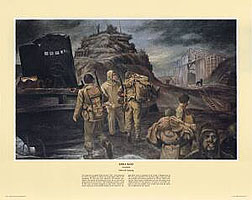
KISKA RAID - Aleutians
by Edward Laning
The Japanese occupied Kiska in June 1942, and planning for active operations to retake the island began almost immediately. For the next year, whenever the weather permitted, the island was bombarded from the air and sea in preparation for an invasion. The bombing reached a peak of 424 tons of bombs dropped in July 1943. However, when American forces finally landed on the island in August there were no Japanese to be found. Unbeknownst to the American planners, the Japanese High Command had successfully evacuated its garrison on 29 July. While finding the island empty of defenders proved something of an embarrassment to the planners, it came as a welcome surprise to the foot soldiers who would have had the nasty job of fighting for the island.